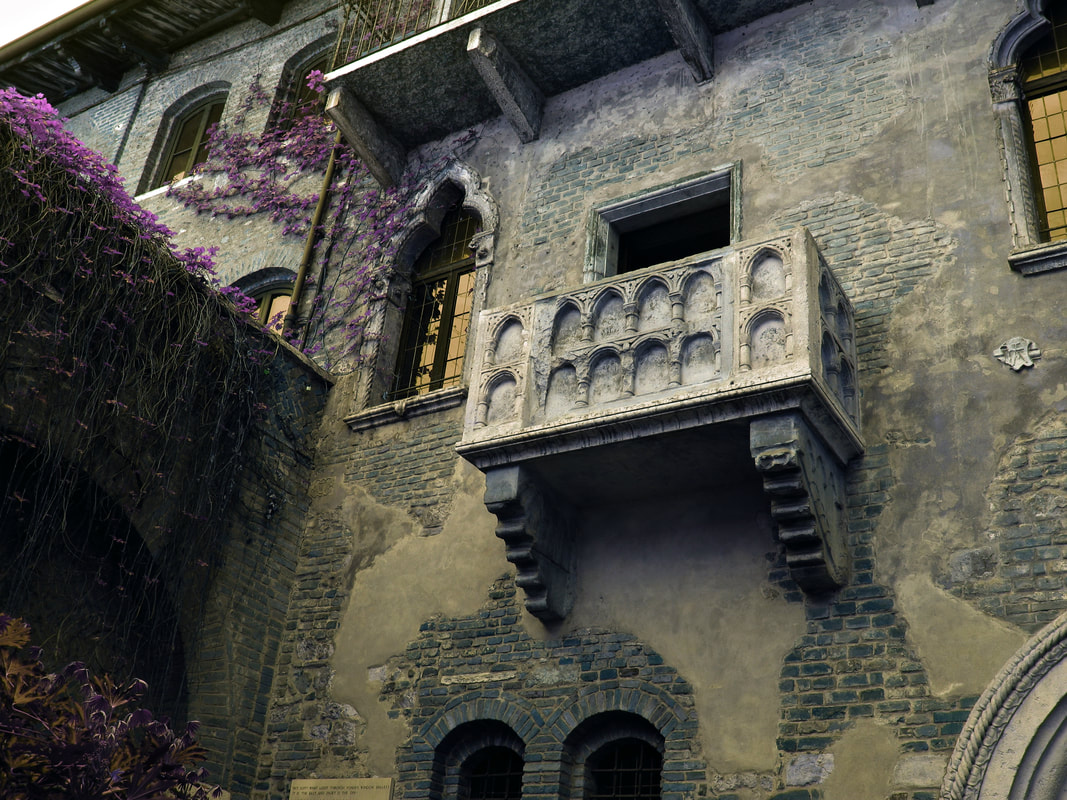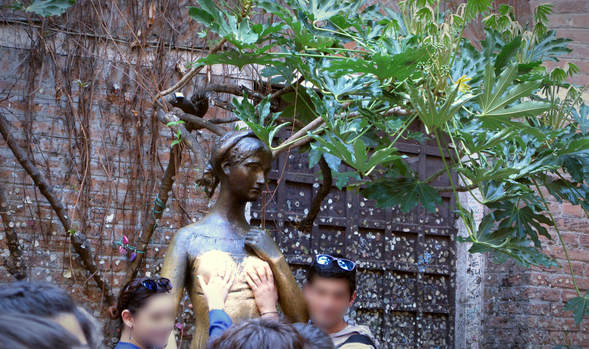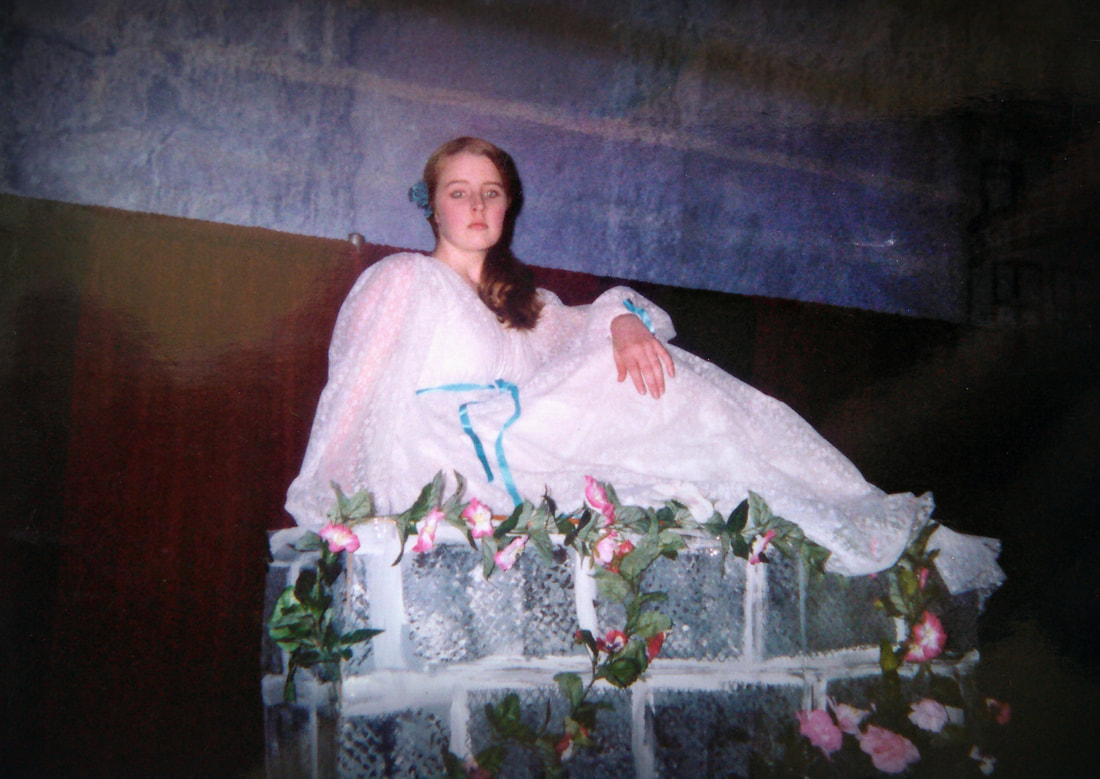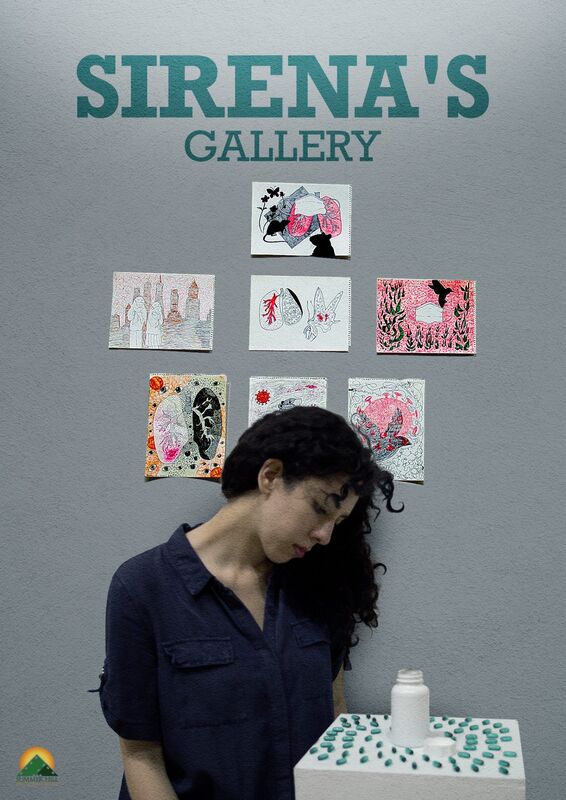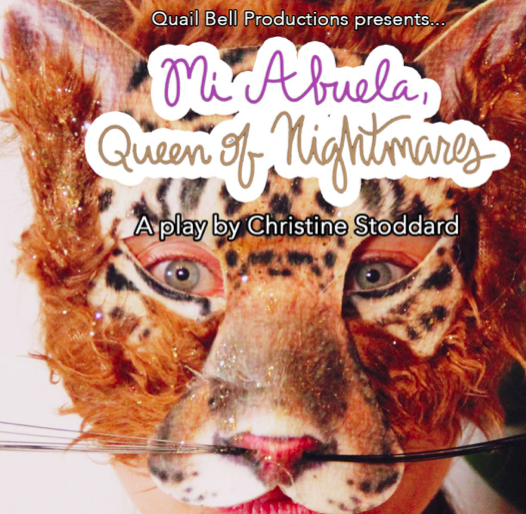|
The Breadcrumbs widget will appear here on the published site.
Balconies, Breasts, and Death: Exploring Juliet's Verona (Valentine's Edition)Words and Images by Emily Linstrom QuailBellMagazine.com *Editor’s Note: First appeared in Rebelle Society. Intro: Verona, Italy is in fact two cities: There is the Roman, in ruins, underground, a network running beneath the streets, and fair Verona, where we lay our scene. Prologue The story of Giulietta e Romeo is based on events that took place between the 13th-14th centuries, concerning two families of opposing political factions under the Scala reign. (Italy at the time was a country made up of many inlaid countries, each with its own ruling kingdom.) While the rival Montecchi and Capuleti families did in fact exist, with Dante himself giving them a nod in his Divine Comedy, it’s likely that their names made it onto the R &J marquee as a result of creative licensing. So here’s the six-degrees-of-Kevin-Bacon: Shakespeare lifted the tale from Matteo Bandello’s play, which was adapted from the novel by Luigi da Porto, who likely pieced it together from word-of-mouth accounts. Obviously the star-crossed lovers trope is a tale as old as time, spanning numerous countries and cultures, but I guess something about this one stuck. I could pen a separate piece altogether on the history and richness and maddening beauty of Verona—and of Italy at large—but it would be an exercise in futility by sheer virtue of excess. I spent a week in Verona flying solo, with my partner joining me the last few days, and it was—is—a portal to another world, and the Italy we all dream of, each in our own way. I discovered mine, you’ll discover yours, and in the mean time we’ll examine a few vignettes from a certain hormonal debacle. Act I: Balconies According to the world, its greatest love story was played out from a balcony, between two teens who would know each other for less than a week. Fair enough. I’ve found love in that amount of time too, and sometimes even thought it was worth dying for. The story of Juliet and her Romeo is the shepherd of tourism that keeps Verona suspended in perpetual spring: wedding parties, honeymooners, and horny couples clamber over Roman ruins to get to Capulet’s courtyard so they can scrawl their love on the walls and padlock it down and insist that this really happened. Like Shakespeare’s immortal pair, most of them only have this in common: each other. Fair enough. I’ve been in relationships where self was not a factor either, only the other. Bestselling love doesn’t really allow for separate lives and secret selves where its key players are concerned; at most we’re offered a complimentary peek every now and then. Despite their nuances, commercially appealing lovers are somewhat bland stand-ins for our own projected desires. Vampire, artist, socialite, bookworm, misunderstood youth: pick a prototype. I have no idea what Juliet wanted for herself before Romeo, her favorite thing to eat or read or just do on an afternoon off. I have no idea what it was like when she got her first period, if it was the nurse who comforted her or her mother or if she had even started bleeding when she met Romeo. (Remember, “she hath not seen the change of fourteen years” and medieval diets were lousy.) I want to know these things, because I remember myself at thirteen, the thoughts I held and emotions I harbored. My world within was at its loveliest, while the world without was decidedly wretched. Was Juliet picked on by other girls or was she kind of a jerk herself? Did she even have girlfriends? All we ever learn about her is that she’s beautiful, rich, thirteen, and willing to marry and die for the first boy she loves. (Which almost makes you wish she’d gone for Mercutio. Mad, bad, brilliant Mercutio; I’ve always preferred him to Romeo. He’d have either ushered the renaissance into Juliet’s life or driven her to suicide anyway.) The Capuleti House, built in the 14th century, sits just off the city centre and you’ll know it when you see it. You can pay to go inside, stroll through the rooms, look at the costumes worn by Olivia Hussey and Leonard Whiting in Zeffirelli’s 1968 adaptation and, best of all, stand on the balcony, THE balcony. I didn’t pay to go in, but I watched from below and it’s amazing what a balcony can do for one’s gusto. Parents proudly—and precariously—balanced their babies on the ledge while women ranging from their teens to seventies fairly glowed as if in the first light of love. Couples kissed and posed for photos, some even waved down to us groundlings. One bored kid hawked a loogie and was thumped upside the head by his dad. It’s a fine balcony, but it’s hard to imagine the murmured exchange of sweet nothings between an elevated Point A and earthbound Point B. In the play Romeo and Juliet lock neither lips nor limbs in the balcony scene, so I’d have to go with Zeffirelli’s foliage-laden secret garden terrace or even Baz Luhrmann’s dumb swimming pool scenario to believe any intimacy could have been achieved without alerting the entire household. (“Indoor voices aren’t really an Italian thing,” a friend helpfully pointed out.) If you think about it (and I did), the original balcony scene was the pre-cursor to sexting. Act II: Breasts There is a bronze statue in the Capuleti courtyard, erected in the sixties, of Juliet. She is slender and somewhat pensive, and her breasts have been rubbed to a high sheen. Tradition says it’s good luck to grope this statue of Juliet, so grinning visitors from around the world—young men, old men, nuclear families, mothers and daughters—gather round and pose for photos with their hands cupped over her breasts. I tried telling myself that it was uptight and matronly of me to be bothered by this, a kind of grasping-at-straws feminist outrage, that it was just a statue of a fictional thirteen year-old character. But then I remember when my own breasts came in at eleven, twelve, thirteen; how boys and grown men and even women commented on them, grabbed at them, made openly crude comments, instilling in me from the get-go that what I had was not mine and I had better get used to it. When I started having sex in my twenties (Juliet definitely beat me to that one), I had to remind lovers not to bite/suck/slap so hard, that larger breasts didn’t mean less sensitivity, that my more-than-a-handful wasn’t, in fact, a waste. Later, like a sister of Shylock, I thought I could rehabilitate that pound of flesh through burlesque and nude modeling, proving to the world that I could—and would—employ what I had with pride and zero shame because fuck you. It worked for awhile, but a few years ago I put my clothes back on. In the end I was a chick with a mind and spirit but large tits and well, large tits don’t typically get to be poignant. What I had wasn’t a message at all, but an invitation. It’s exhausting business, occupying a woman’s body. I don’t know about you, but I can’t tell you how many times I’ve wished I could turn mine to bronze. Ultimately, I couldn’t not consider the perverse irony of rubbing Juliet’s breasts raw for good luck. Because isn’t that how we approach the flesh-and-blood bodies of our women? When we’re young and nubile and inexperienced we welcome worship and exploitation; to view or be near or touch us (invited or not) is ownership by proxy. Had Juliet lived to a wizened age we’d recoil from those breasts, low and deflated from years of gravity and nursing babies. We’d suggest that Romeo upgrade to a newer model. I started to scribble a poem in Verona titled “I Want To Steal The Breasts Of Juliet,” and while I never finished it, the sentiment still lingers. I still want to pick her statue up and spirit her away to somewhere safe and quiet, where I can buy her a Spritz and sit with her, let her rest, listen. (I’d suggest a certain spot by the river but you’ll find out in Act III how that went down.) I’d even offer to pull the dagger from her breast, whispering keep it, and don’t be afraid to use it. 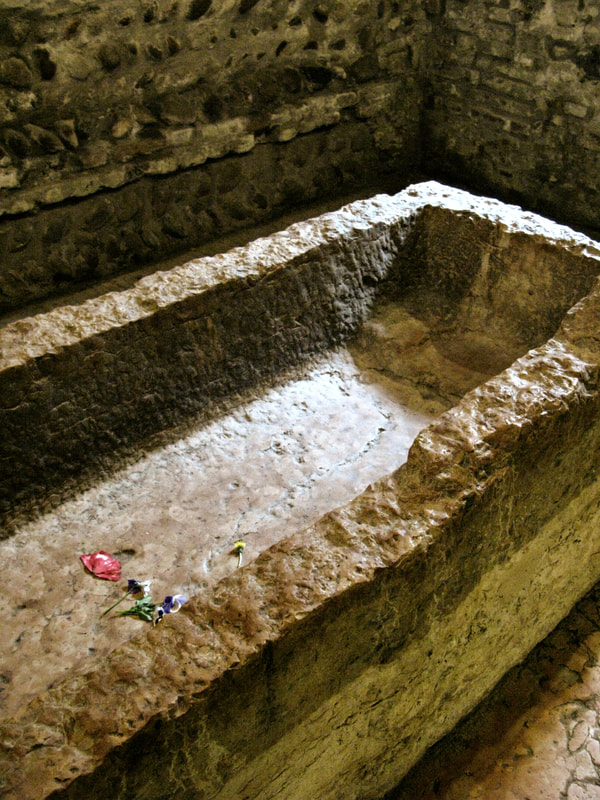 Act III: Death Here’s the thing about Verona: you’re never alone. Wherever you go, there are people—ok, tourists. And not just any kind of tourist, the obnoxious kind impervious to personal space and the solitary sensations of fellow travelers. The world is their stage, or rather their movie set, and the script is a self-penned biopic happening in real time. In Venice, for shits and giggles, I’d pull out my camera and pretend to photograph something really phenomenal, which was actually just a cigarette butt or nondescript doorknob or cobblestone or something. And sure enough, I’d soon be surrounded by a throng of confused tourists jostling one another, cameras poised and ready, trying to figure out what they were missing out on. That’s right, dance puppets! Anyway, at the golden hour one afternoon I thought I found a small, secluded spot by the river to sit and dip my feet and gaze at the Castelvecchio bridge. A few swans and a family of ducks took some laps back and forth, and it felt nice to think they were cool with me being there. In less than ten minutes I was joined by a group of young backpackers with selfie sticks, who were then joined by a giggling teapot-armed girlfriend being directed in an impromptu photoshoot by her boyfriend. They all cast sheepish glances my way, like they knew they were intruding on something that wasn’t even worth it. At the same time, however, it was equally evident that they were damn well going to get their money’s worth because it clearly looked like I was. The waterfowl peaced out even before I did. Not the least bit ironically, the only place I was able to find some peace and quiet was in La Tomba di Giulietta or simply, Juliet’s Tomb. (Everything sounds prettier in Italian.) So this is probably the most confusing of the R & J hotspots in Verona, mostly because it’s the biggest fib everyone glosses over. While the story of Romeo & Juliet is rooted in truth, and their designated houses more or less in line with the era and families, the sarcophagus in question belonged to some rando whose bones I can only imagine were dumped out to make room for the headlining act. The story goes that it is in fact Juliet’s tomb, that her remains were moved to an undisclosed location to avoid future disturbances. Sure, sounds good. And you know, I’d love to believe that, because I want to believe that kind of delicious intrigue can exist in this world, that the supposed tombs of star-crossed lovers cradled real bodies, their bodies. Like Mulder from the X Files, I WANT TO BELIEVE. But in that cavernous little vault beneath the abbey of San Francesco al Corso all I could think about was the tomb’s rightful and evicted tenant. Was it a woman who had also taken her own life, whose name had been x’d out so Juliet’s could replace it? Or did childbirth claim her, as was so often the case in centuries prior? Was it a high-ranking soldier who died on the battlefield or, conversely, an old man in his bed? OR was he/she taken by the plague, a perfectly reasonable assumption given the number of lives wiped out during the Middle Ages? I’m not usually this sentimental about the earthly remnants of death. In my opinion the good stuff happens beyond the grave, and what’s left is mostly just costly/smelly/fussed-over debris. Maybe it’s a creative ownership thing. Breasts or tombs, moments of privacy or personal narratives—rightful ownership shouldn’t be so hard. Epilogue I got engaged in Verona on the 9th of April, 2017 in front of the coliseum, which was built 50 years prior to its more famous cousin further south. The handmade ring was gold-dipped bronze, an unintentional acknowledgement of Juliet’s alchemized flesh, the three stones were raw, and the Roman design was in keeping with the city’s ancient origins. No balconies for us; we were adults, with adult experiences and backstories and flaws and former loves and surprising bends in the road that had, miraculously, brought us together. Call me a boring old grown-up, but I think that’s a helluva lot more romantic than unblemished teenage love cut short in a co-opted crypt. The author on her 14th birthday, playing Juliet for a touring Shakespeare festival. Clearly not amused with Romeo creeping on her business.
CommentsComments are closed.
|
|

